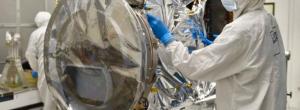TEMPO Air Pollution Sensor Books A Ride To Space
TEMPO (Tropospheric Emissions: Monitoring of Pollution), a NASA Earth science instrument that will dramatically advance our understanding of air quality over North America, has secured a satellite host and ride into space.

TEMPO instrument.
Maxar Technologies of Westminster, Colorado, will provide satellite integration, launch and data transmission services for NASA’s TEMPO, an Earth science mission led by Principal Investigator Kelly Chance from the Smithsonian Astrophysical Observatory (SAO) in Cambridge, Massachusetts. According to Chance, "the contract with Maxar brings TEMPO one step closer to high resolution, hour-by-hour air quality monitoring from space."
A contract with Maxar was awarded by the U.S. Air Force Space and Missile Systems Center through its Hosted Payload Solutions contract, a procurement mechanism that provides a pool of qualified vendors that meet the government's needs for various hosted payload space missions at a cost savings to the government.
Scheduled to fly in 2022 on a 1300-class commercial satellite provided by Maxar, TEMPO will make its hourly measurements of atmospheric gases including ozone, nitrogen dioxide and formaldehyde, as well as aerosols across North America, from a geostationary vantage point 35,786 km (22,236 mi) miles above Earth's equator.
While ozone is a major protector of life on Earth and filters out harmful ultraviolet radiation, it is also a greenhouse gas and major air pollutant. TEMPO's new stream of data will provide near-real-time air quality products that will be made publicly available, and will help improve air quality forecasting. TEMPO will also enable researchers to improve pollution emission inventories, monitor population exposure, and evaluate effective emission-control strategies.
The TEMPO instrument was recently completed by Ball Aerospace in Boulder, Colorado, and is in storage awaiting shipment to Maxar's satellite manufacturing facility in Palo Alto, California.
“With the TEMPO instrument fully spaceflight qualified and safely delivered, we are excited about this important step and look forward to working closely with Maxar for the successful deployment of TEMPO," said Stephen Hall, TEMPO project manager at NASA's Langley Research Center in Hampton, Virginia.
TEMPO will contribute to a global air-quality monitoring constellation that will include similar satellites: European Space Agency's Sentinel-4, currently in development, and South Korea’s Geostationary Environment Monitoring Spectrometer, scheduled to launch in early 2020.
Source: Center for Astrophysics, Harvard & Smithsonian
- 236 reads
Human Rights
Fostering a More Humane World: The 28th Eurasian Economic Summi

Conscience, Hope, and Action: Keys to Global Peace and Sustainability

Ringing FOWPAL’s Peace Bell for the World:Nobel Peace Prize Laureates’ Visions and Actions

Protecting the World’s Cultural Diversity for a Sustainable Future

Puppet Show I International Friendship Day 2020

